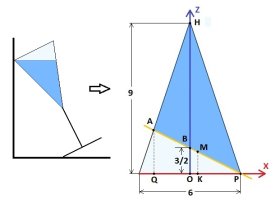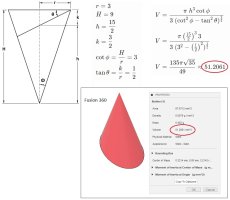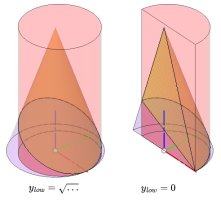Janosik
New member
- Joined
- Mar 2, 2024
- Messages
- 11
Hello everyone,
My question is not about homework. It's about a math problem I recently came across on Facebook.
It's been a while since I was in school, but I always enjoyed mathematics.
Here is the question:
A conical glass is tilted against a wall. It is filled to the brim with water. Calculate the volume of water.

I want to use the 'rod method' (as in not use the 'slices method').
Just to make sure we're talking abaout the same thing: I want to add the volume of an infinite number of rods, each rod being infinitely thin, starting at a bottom surface and reaching a top surface. This explanation is probably technically wrong, but I hope you understand what I mean.
[math]W=\int_{x_{low}}^{x_{high}}\int_{y_{low}}^{y_{high}}\int_{z_{low}}^{z_{high}}1\;dz\;dy\;dx[/math]
This is what I've found so far:
The equation of the cone is [imath]C:x^2+y^2=\left(\frac{9-z}{3}\right)^2[/imath]
Isolating z gives: [imath]z_{high}=9-3\sqrt{x^2+y^2}[/imath]
The equation of the inclined plane is [imath]V:2z+x=3[/imath]
Isolating z gives: [imath]z_{low}=\frac{3-x}{2}[/imath]
The intersection of the cone and the plane is an ellipse.
It's projection on the XY-plane is also an ellipse with equation [imath]E:35x^2-30x-255+36y^2=0[/imath]
Isolating y gives: [imath]y_{high}=\frac{1}{6}\sqrt{255+30x-35x^2}[/imath]
I chose to set [imath]y_{low}=0[/imath] (this wiil result in half the volume i'm looking for).
Point P is at: [imath]P(3,0,0)[/imath]
So [imath]x_{high}=3[/imath]
Point Q is at: [imath]Q\left(-\frac{15}{7},0,0\right)[/imath]
So [imath]x_{low}=-\frac{15}{7}[/imath]
Putting these results in the integrals, and trying to let my solver do the work gives this:

Sooo... can somebody please tell me what I'm doing wrong?
Thank you!
My question is not about homework. It's about a math problem I recently came across on Facebook.
It's been a while since I was in school, but I always enjoyed mathematics.
Here is the question:
A conical glass is tilted against a wall. It is filled to the brim with water. Calculate the volume of water.

I want to use the 'rod method' (as in not use the 'slices method').
Just to make sure we're talking abaout the same thing: I want to add the volume of an infinite number of rods, each rod being infinitely thin, starting at a bottom surface and reaching a top surface. This explanation is probably technically wrong, but I hope you understand what I mean.
[math]W=\int_{x_{low}}^{x_{high}}\int_{y_{low}}^{y_{high}}\int_{z_{low}}^{z_{high}}1\;dz\;dy\;dx[/math]
This is what I've found so far:
The equation of the cone is [imath]C:x^2+y^2=\left(\frac{9-z}{3}\right)^2[/imath]
Isolating z gives: [imath]z_{high}=9-3\sqrt{x^2+y^2}[/imath]
The equation of the inclined plane is [imath]V:2z+x=3[/imath]
Isolating z gives: [imath]z_{low}=\frac{3-x}{2}[/imath]
The intersection of the cone and the plane is an ellipse.
It's projection on the XY-plane is also an ellipse with equation [imath]E:35x^2-30x-255+36y^2=0[/imath]
Isolating y gives: [imath]y_{high}=\frac{1}{6}\sqrt{255+30x-35x^2}[/imath]
I chose to set [imath]y_{low}=0[/imath] (this wiil result in half the volume i'm looking for).
Point P is at: [imath]P(3,0,0)[/imath]
So [imath]x_{high}=3[/imath]
Point Q is at: [imath]Q\left(-\frac{15}{7},0,0\right)[/imath]
So [imath]x_{low}=-\frac{15}{7}[/imath]
Putting these results in the integrals, and trying to let my solver do the work gives this:

Sooo... can somebody please tell me what I'm doing wrong?
Thank you!


